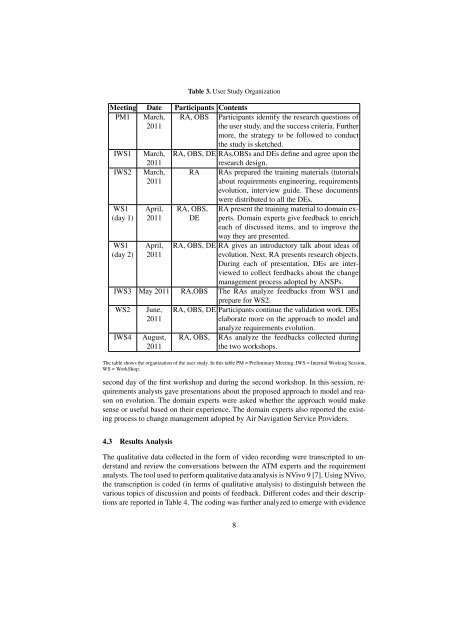D.3.3 ALGORITHMS FOR INCREMENTAL ... - SecureChange
D.3.3 ALGORITHMS FOR INCREMENTAL ... - SecureChange
D.3.3 ALGORITHMS FOR INCREMENTAL ... - SecureChange
You also want an ePaper? Increase the reach of your titles
YUMPU automatically turns print PDFs into web optimized ePapers that Google loves.
Table 3. User Study Organization<br />
Meeting Date Participants Contents<br />
PM1 March,<br />
2011<br />
RA, OBS Participants identify the research questions of<br />
the user study, and the success criteria. Further<br />
more, the strategy to be followed to conduct<br />
the study is sketched.<br />
IWS1 March, RA, OBS, DE RAs,OBSs and DEs define and agree upon the<br />
IWS2<br />
WS1<br />
(day 1)<br />
2011<br />
March,<br />
2011<br />
April,<br />
2011<br />
RA<br />
RA, OBS,<br />
DE<br />
research design.<br />
RAs prepared the training materials (tutorials<br />
about requirements engineering, requirements<br />
evolution, interview guide. These documents<br />
were distributed to all the DEs.<br />
RA present the training material to domain experts.<br />
Domain experts give feedback to enrich<br />
each of discussed items, and to improve the<br />
way they are presented.<br />
WS1<br />
(day 2)<br />
April,<br />
2011<br />
RA, OBS, DE RA gives an introductory talk about ideas of<br />
evolution. Next, RA presents research objects.<br />
During each of presentation, DEs are interviewed<br />
to collect feedbacks about the change<br />
management process adopted by ANSPs.<br />
IWS3 May 2011 RA,OBS The RAs analyze feedbacks from WS1 and<br />
WS2<br />
IWS4<br />
June,<br />
2011<br />
August,<br />
2011<br />
prepare for WS2.<br />
RA, OBS, DE Participants continue the validation work. DEs<br />
elaborate more on the approach to model and<br />
analyze requirements evolution.<br />
RA, OBS,<br />
RAs analyze the feedbacks collected during<br />
the two workshops.<br />
The table shows the organization of the user study. In this table PM = Preliminary Meeting, IWS = Internal Working Session,<br />
WS = WorkShop.<br />
second day of the first workshop and during the second workshop. In this session, requirements<br />
analysts gave presentations about the proposed approach to model and reason<br />
on evolution. The domain experts were asked whether the approach would make<br />
sense or useful based on their experience. The domain experts also reported the existing<br />
process to change management adopted by Air Navigation Service Providers.<br />
4.3 Results Analysis<br />
The qualitative data collected in the form of video recording were transcripted to understand<br />
and review the conversations between the ATM experts and the requirement<br />
analysts. The tool used to perform qualitative data analysis is NVivo 9 [7]. Using NVivo,<br />
the transcription is coded (in terms of qualitative analysis) to distinguish between the<br />
various topics of discussion and points of feedback. Different codes and their descriptions<br />
are reported in Table 4. The coding was further analyzed to emerge with evidence<br />
8


